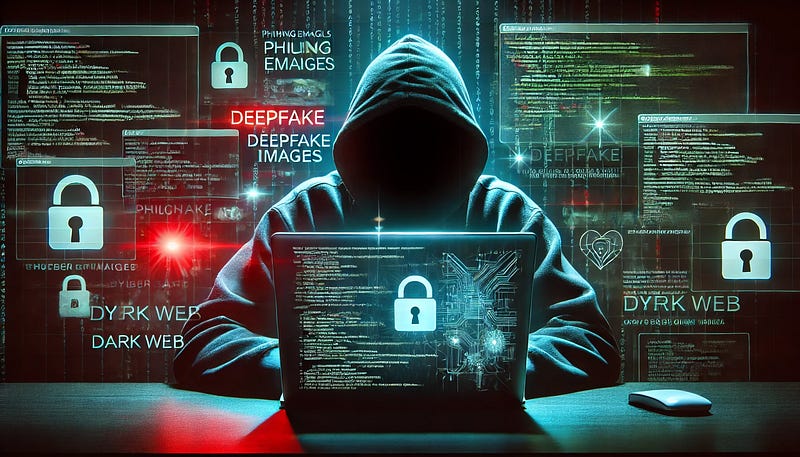The Dark Web and Generative AI: How AI is Supercharging Cybercrime
Generative AI (Gen AI) is reshaping cybercrime, and nowhere is this more apparent than on the dark web. What used to require serious…
Generative AI (Gen AI) is reshaping cybercrime, and nowhere is this more apparent than on the dark web. What used to require serious technical skills is now accessible to almost anyone thanks to AI-powered hacking tools. Criminals no longer need to code their own malware or craft convincing phishing emails — AI is doing the heavy lifting for them.
This isn’t just speculation; reports from Europol, Check Point Research, and cybersecurity firms confirm that AI-driven cybercrime is already here. Dark web forums are actively discussing AI-powered hacking, and some criminal groups are believed to be training their own AI models using stolen datasets.
But is this really as bad as it sounds? Are AI-driven cybercriminals already running rampant, or is this just another evolution in the ongoing battle between hackers and security experts? Let’s take a deep dive into how underground AI models are being built and sold, how they are changing the face of online crime, and what this means for the future of cybersecurity.
The Rise of Dark Web AI Models: Beyond WormGPT and FraudGPT
Most AI tools, like ChatGPT, come with strict ethical constraints to prevent abuse. But cybercriminals have built their own versions, free from restrictions. Tools like WormGPT and FraudGPT have appeared on dark web forums, offering:
AI-generated phishing emails that evade spam filters.
Automated malware and ransomware scripts — no coding knowledge required.
Chatbots for social engineering scams that manipulate victims in real-time.
Automated hacking tools that scan websites for vulnerabilities.
Is AI-Powered Hacking Already a Reality?
Some security researchers believe criminals are training their own AI models, fine-tuning existing open-source tools like GPT-J and LLaMA.
AI-generated cybercrime services have increased by 135% in the past year, with deepfake scams, AI-assisted fraud, and automated hacking tools becoming mainstream. (Check Point Research, 2023)
In July 2023, the FBI arrested individuals selling AI-generated deepfake IDs and synthetic identity fraud kits on dark web forums. (FBI Cybercrime Report, 2023)
Leaked dark web logs suggest that hackers are experimenting with fine-tuning LLMs using stolen corporate data.
We’re still in the early days, but the trend is clear — AI is removing barriers and making cybercrime more accessible than ever.
How AI is Supercharging Cybercrime Kits
Before AI, criminals had to buy hacking kits from dark web markets and manually configure them. Now, AI-driven cybercrime has turned into a plug-and-play service.
Traditional vs. AI-Powered Cybercrime Kits
Before AIAfter AINeeded coding skills to create malware.AI writes custom malware in seconds.Phishing scams relied on copied email templates.AI generates personalised phishing emails.Malware had to be tested and debugged manually.AI refines malware in real-time.Hackers negotiated ransom payments.AI chatbots handle negotiations.
Take AutoPhisher, an AI-driven phishing tool for sale on the dark web. It creates personalised scam emails that adjust wording based on the victim’s job, interests, and past interactions — something no traditional phishing kit could do.
Ransomware gangs are also using AI chatbots to negotiate payments, adapting to victims’ emotions and pushing them towards paying up. This shift is making cybercrime more profitable, scalable, and harder to detect.
AI-Powered Malware: The Next Big Cyber Threat
The most worrying impact of Gen AI on the dark web? Self-learning malware.
How AI is Changing Malware
Self-modifying malware — AI changes its own code to evade detection.
Automated payload selection — AI picks the best attack method based on the target’s security setup.
AI-assisted zero-day exploits — AI scans leaked source code and security flaws before researchers can patch them.
Case Study: DarkBERT and Malicious AI Training
Researchers recently discovered DarkBERT, an AI model trained on dark web data to analyse criminal behaviour. While built for cybersecurity research, criminals are training their own AI models using stolen datasets, malware, and hacking forum discussions. (Cybersecurity Ventures, 2023)
This means future malware could think, adapt, and evade defences without human control — a nightmare scenario for cybersecurity experts.
How Law Enforcement is Fighting Back
Governments and security firms are scrambling to fight back, but AI-powered cybercrime is evolving fast.
Law Enforcement Actions
AI-Powered Cyber Defences — Google, Microsoft, and others are using AI to detect AI-written phishing emails and AI-generated malware.
Shutting Down AI Marketplaces — In October 2023, Europol dismantled a dark web marketplace selling AI-driven hacking tools. (Europol Report)
Tighter AI Regulations — Some governments are considering restricting access to powerful AI models to prevent abuse.
Despite this, the dark web remains resilient. Every time one marketplace is shut down, another pops up within weeks.
The Future: AI vs AI in Cybersecurity
The dark web’s embrace of Generative AI has already changed cybercrime. As AI models become even more powerful, we could see:
Fully autonomous AI hackers — AI-driven bots launching attacks in real-time.
AI-generated zero-day exploits — AI models discovering and exploiting vulnerabilities faster than humans.
AI-powered deepfake scams at scale — Automated, AI-driven fraud that’s indistinguishable from reality.
To stay ahead, cybersecurity must evolve just as fast as AI-driven threats. The battle against AI-powered cybercrime is only just beginning.
What Do You Think?
Are we already seeing autonomous AI hacking tools? Should governments regulate AI models to prevent cybercriminals from abusing them? Let me know your thoughts below! 👇


